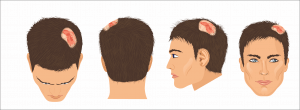Scarring Alopecia
 Cicatrical Alopecia, also known as Scarring Alopecia, is a condition that can result in the total or partial losses of both scalp and body hair. It occurs as the result of gross scars or micro scarring at the cellular levels. The damage happens following inflammatory conditions caused by dermal inflammatory conditions and infections.
Cicatrical Alopecia, also known as Scarring Alopecia, is a condition that can result in the total or partial losses of both scalp and body hair. It occurs as the result of gross scars or micro scarring at the cellular levels. The damage happens following inflammatory conditions caused by dermal inflammatory conditions and infections.
The cause of this condition is not well known by physicians. The skin around the hair follicles usually becomes characterized by redness, pain and swelling. The hair follicles that are targeted by the damaging process of the condition can be lost forever if the stem cells and oil glands in that areas are destroyed.
Due to the destructive nature of the condition, early diagnosis is extremely important to prevent permanent damage to the scalp. A scalp biopsy can be used to determine how far along the condition has progressed and what treatment options are best for the condition of the specific patient.
Options available to treat the condition include oral medication, topical antibiotics, anti-inflammatory medicines and (in some extreme cases) surgical hair restoration.
When Hair Transplant Can Help
Hair transplantation could be used for treatment of balding areas in Cicatricial Alopecia. A variety of results have been reported on hair transplants into the Cicatricial Alopecia lesions. In order to qualify a patient for hair transplant, a scalp biopsy should be performed to rule out any active lesions. If there is no active disease detected, a test hair transplant could be performed in which a small number of grafts will be transplanted into the lesions to assure the growth.
Due to the diversity of the causes and types of CA lesions, they may respond differently to hair transplantation. Patients should know there might always be a risk of losing some of the transplanted hairs into the Cicatricial lesions in many types of this condition.